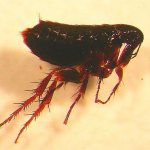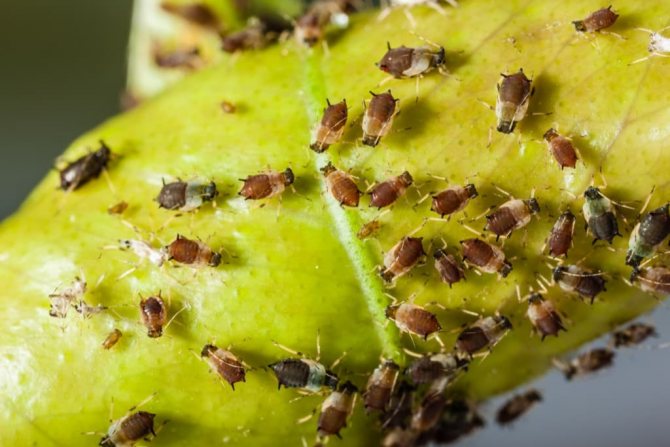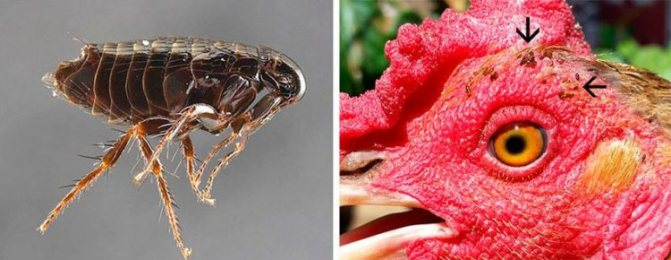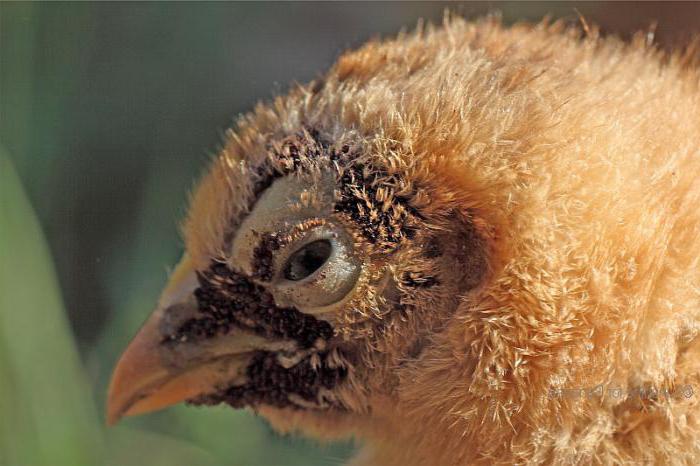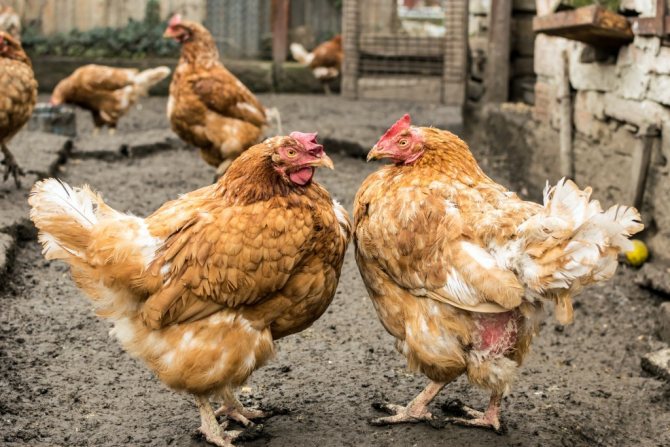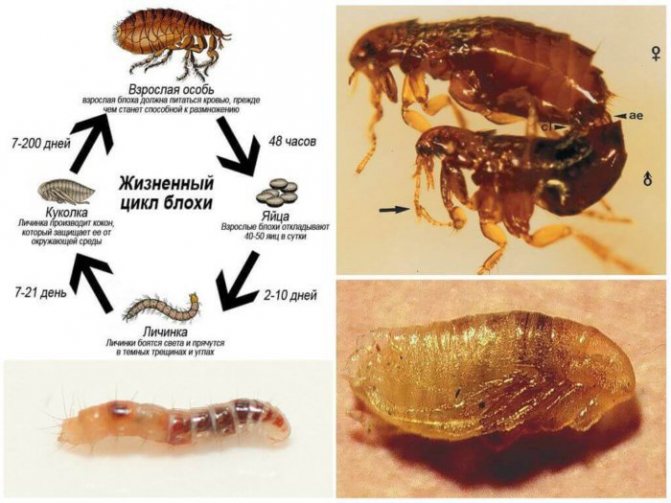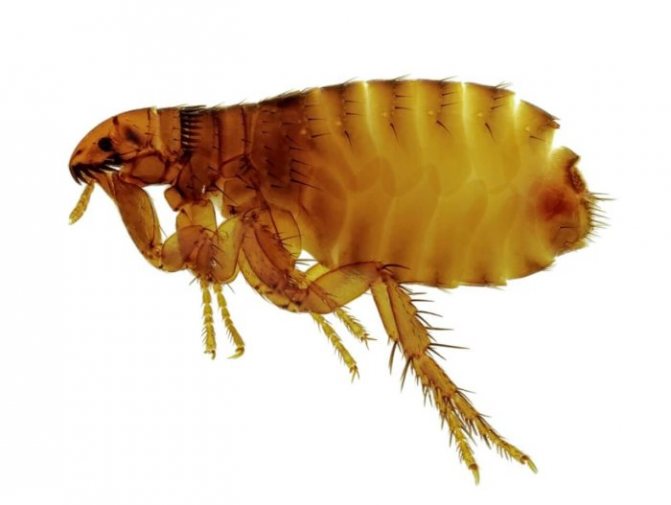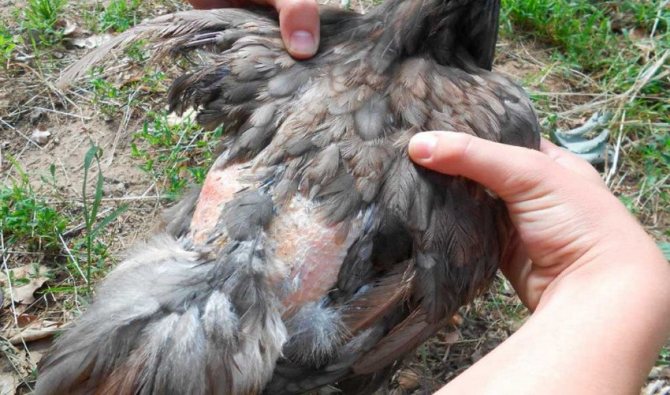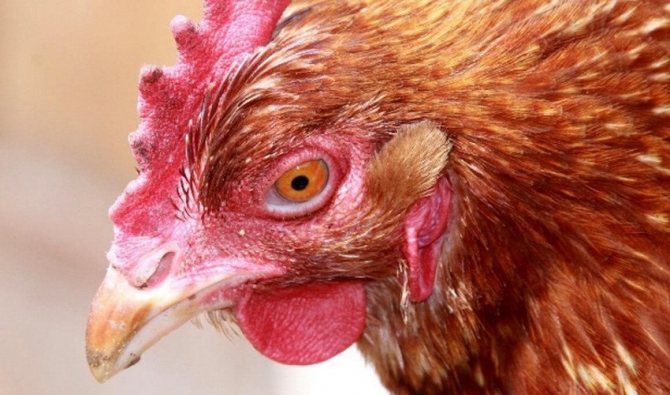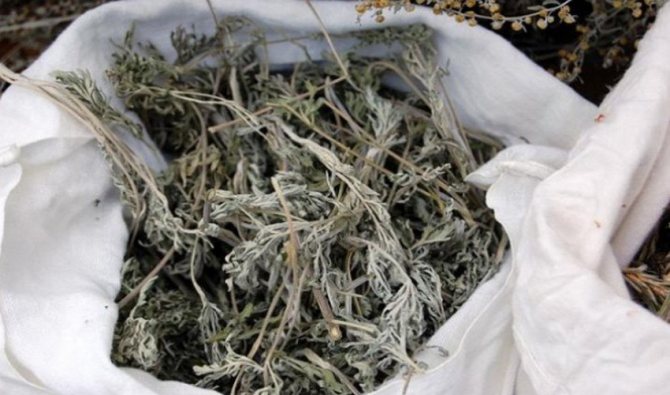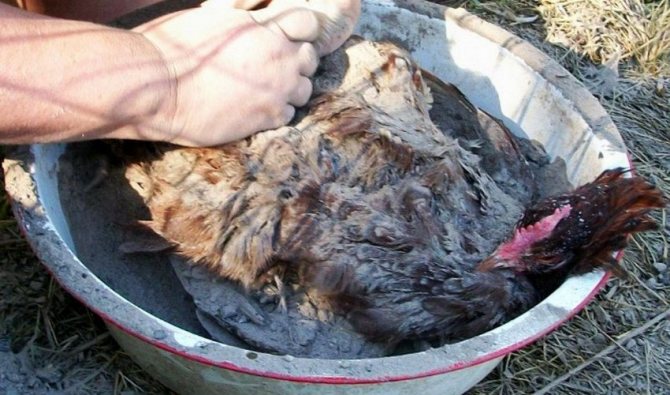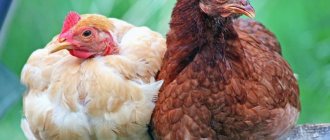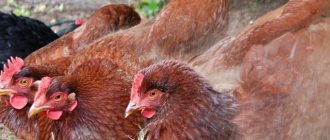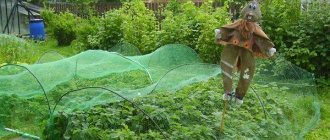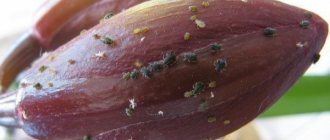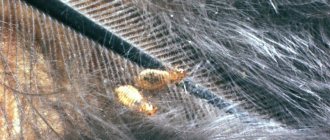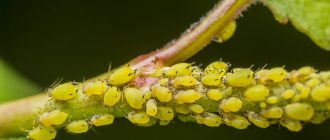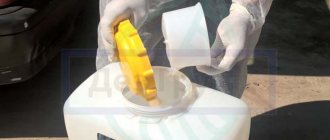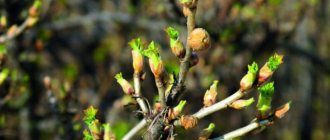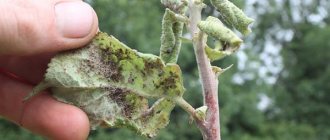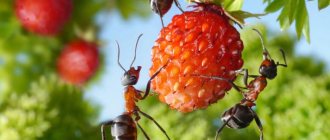Chicken fleas are a widespread parasite that attacks both domestic and wild birds. This type of insect lives even on parrots, but it does the most harm to agricultural birds. If a flea gets into the barn, then in seven days the number of parasites will increase 50 times! Then they will multiply exponentially. Therefore, it is necessary to regularly carry out preventive measures, notice the infected bird in time and carry out its treatment.
Chicken fleas
Chicken fleas: where they come from, symptoms and consequences of infection
Parasites start in chickens not only because of the unsanitary conditions of the chicken coop - there are quite a few sources of infection. The pest is carried by wild birds, but they can also migrate from nearby poultry farms. Flea eggs are found in hay or straw used as bedding for the poultry house.
At first, the infection of the laying hen is relatively difficult to notice due to the small size of the pest and the fact that it is hidden under the feathers. When parasites appear on exposed areas of the skin, on the head or legs, it is a sign that the chicken's body is infested with insects. The accumulation of fleas on the head visually resembles moles.
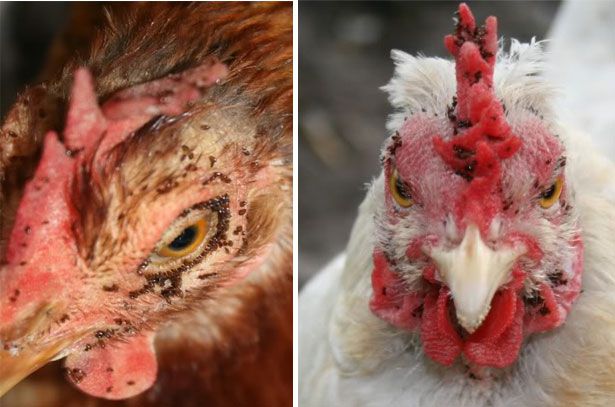
Infected chickens
Affected animals lay few eggs and practically stop moving. Following this, they develop anemia and anemia, which can be determined by the white crest. The next stage is exhaustion, the last one is death. It should also be remembered that fleas carry a large number of infections, ranging from salmonellosis to trypanosomiasis. There have been cases when they carried pathogens of more serious diseases, such as plague or encephalitis. At the same time, all fleas are carriers of helminth eggs, so there is a chance to become infected with worms from the meat or eggs of the affected chicken.
Life cycle and behavioral features
Adult chicken fleas tolerate temperatures of +40 degrees. They almost always remain on the body of an infected bird.
Sexually mature females lay eggs almost daily, which are scattered around the house with developed hind limbs.
After birth, the larvae of chicken fleas are similar to small worms. They live in the thickness of the litter on the floor of the chicken coop.
The main diet of underdeveloped individuals is organic matter of chicken droppings, they also feed on rotten food, grass, dry blood.
After passing through the growth stage, a morphological change takes place, then transformation into an adult and parasitism on agricultural poultry.
The lifespan of a chicken flea is up to one and a half years. Average term is 8-10 months.
Getting into the chicken coop occurs in the following ways:
- infection from wild birds carrying the pest;
- spontaneous migration of microorganisms from neighboring farms or poultry farms;
- together with bedding.
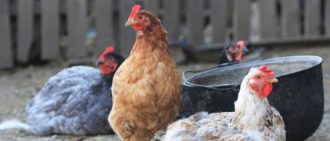

Be sure to read:
What to do when broilers sneeze and wheeze: treatment and prevention
Due to the rapid reproduction, an extremely rapid spread throughout the chicken coop or farm begins.
What a parasite looks like
The bird parasite has a brown-chocolate body, 1-2 mm in size. It has no wings, and it moves by jumping due to its strong and long hind legs.Compared to flat relatives living on pets, it has a tall, flattened body on the sides, making it very difficult to crush the insect. In this case, the body has a chitinous coating, which makes it more durable and practically invulnerable to chickens.
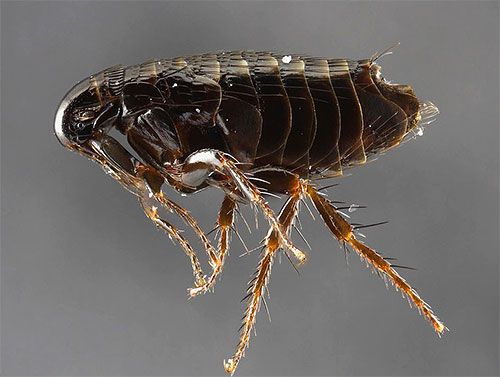

Chicken flea
Flea treatment in a chicken coop
First, they treat chickens for parasites, and then they do pest control of the room, and not vice versa. The litter is not tolerated before processing the barn, because it is in it that the eggs, larvae and pupae are located. Moving sawdust and straw from the coop to the street increases the risk of parasites spreading in the yard. During walking, birds can become infected again.
Spraying with liquid composition
For disinsection of the premises, liquid insecticidal compositions are used. For spraying walls, floors and equipment, you can use the already mentioned drug Butoks. The prepared solution is sprayed over all surfaces and onto the litter. It is recommended to dig it up to its full depth so that the emulsion penetrates inside. The exposure time is 2-3 hours.
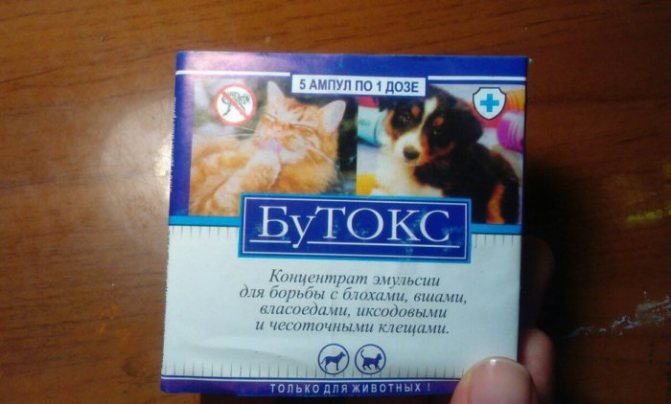

Butox for flea treatment and chicken coop treatment
Only then can the underlying material be taken out into the yard. Then you need to rinse the Butox solution with hot water. After the end of the procedure, the room is ventilated, a clean bedding is laid on the floor.
Attention! During the treatment of the poultry house, hens are not allowed inside. The livestock can be populated after airing.
Fumigation with smoke bombs
Some types of smoke bombs contain permethrin or cypermethrin, powerful poisons that kill parasites. Such pest control products are easy to use - they just need to be placed around the room and set on fire. The smoke will dissipate over the entire area and penetrate into hard-to-reach places, while the farmer does not have to spend time and effort fighting parasites.
List of funds:
- Fomor;
- Fomor-vet;
- Vortex.
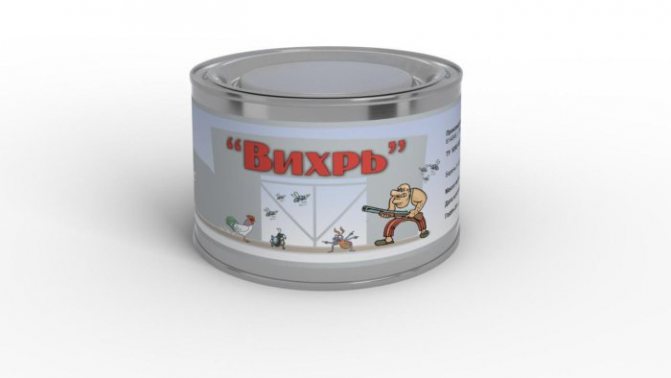

Flea smoke bomb
Before use, chickens are removed from the room, windows are closed and ventilation is turned off. The checkers are placed on a refractory surface - metal or concrete, then set on fire one by one, starting from the farthest from the exit. After that, you need to leave the chicken coop, close the door and wait 2 hours. After the end of the procedure, the barn is ventilated and wet cleaning is done using a soda solution.
Attention! When working with smoke bombs, they wear personal protective equipment - a mask, gloves, overalls. Do not allow insecticides to come into contact with exposed areas of the body, eyes and mouth.
How does a chicken flea live, feed and breed?
This type of parasite, unlike its relatives in mammals, is very thermophilic. Comfortable living conditions for fleas - a carrier with a body temperature of 40-41 ° C. The bird is ideal for these requirements. In other conditions, they will feel discomfort, therefore, they leave the body of the wearer in exceptional cases.
The flea's mouth apparatus cannot bite through thick skin, which explains the rare attacks of parasites on humans. They also do not live in residential buildings if there is no bird in them. The flea diet consists entirely of blood. Often, large accumulations of parasites are found in open areas of the bird's body, because in these places the skin is thinnest.
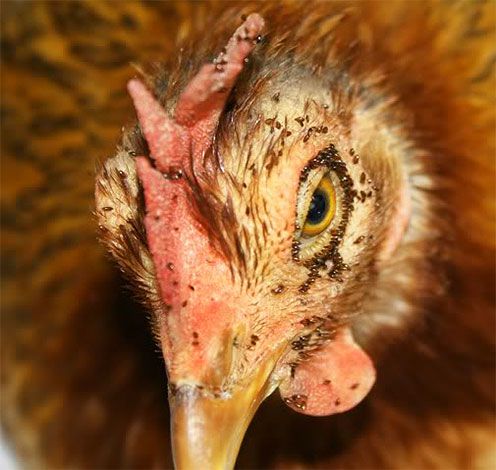

Parasites on exposed skin
The female flea, although it cannot leave its carrier, never leaves an egg on it. To do this, she has special muscles that allow her to push them out of herself at a sufficiently large distance. The flea lays 3-6 eggs daily, which remain in the hen house or bird nests. Within a day, larvae, similar to worms, emerge from the eggs. They grow rapidly, feeding on dried blood, bird droppings and other organic matter. After a couple of weeks, the larvae turn into pupae.
At this stage of development, the parasites stop until the bird is near them for a long time. This often happens when the chrysalis lies in the nest in which hatching begins - here it turns into a flea. Pupae can wait for their carrier for months, staying at rest all this time.
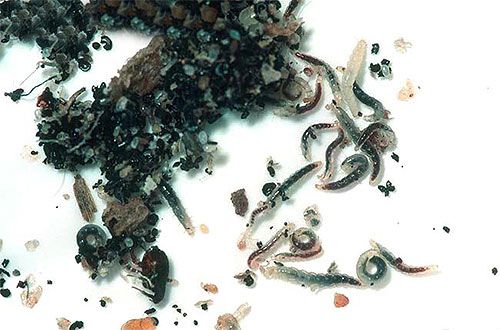

Flea larvae
The life cycle of a chicken flea lasts a couple of months, sometimes more than 12 months. Often, parasites fly with wild birds to new nesting sites, where they continue to breed. On average, several generations of insects grow in the nest per season.
Chickens are especially susceptible to flea attacks in chicken coops, where the situation sometimes becomes especially difficult. The fact is that wild birds leave the nest infested with parasites as soon as the chicks grow up. But chickens cannot do the same. They have to suffer all the time, while fleas, meanwhile, continuously multiply with even greater vigor. Therefore, in case of detection of infected individuals, treatment should be started immediately.
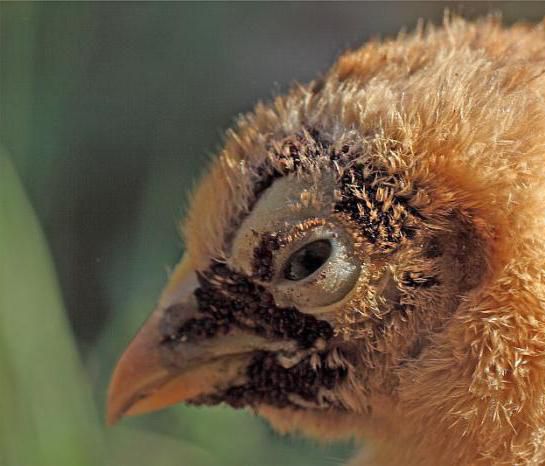

Infected chicken
Description and types
The chicken flea has a laterally flattened body, a dense chitinous cover and a developed piercing-sucking mouth apparatus. The bites are painful and itchy.
Fleas are kept on the skin and feathers of chickens due to tenacious paws and numerous outgrowths and hairs. The hind pair of legs is well developed and allows the insect to jump up to 1.5 m if necessary. Fleas begin to move in this way when the illumination decreases. In daylight, they crawl along the body of the bird closer to its hot skin or feed.
Poultry is parasitized mainly by 2 types of insects:
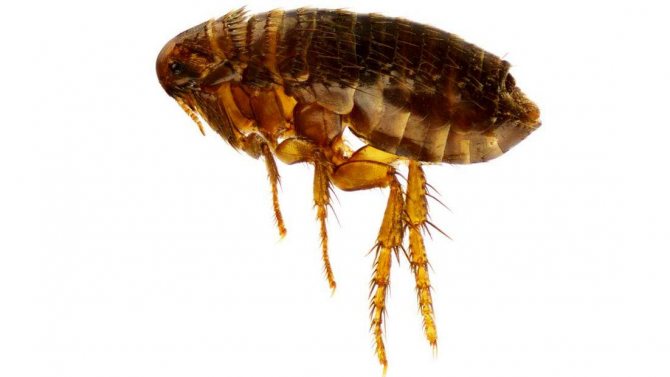

The appearance of a black flea.
- Chicken flea, Ceratophyllus gallinae. It is brown in color, body length - 2-2.5 mm. Inhabits wild and domestic birds, attacks humans and mammals, affects decorative and songbirds.
Distributed in Europe and Asia.
- Black flea, Ceratophyllus niger. This species is often referred to as the western chicken flea. Unlike the previous variety, it has a dark body color and a smaller size (1.5 mm).
Inhabits various types of domestic and wild birds, is capable of transferring to humans or mammals.
Ectoparasites have a similar cycle of development and reproduction, the way of feeding. They carry the same diseases, therefore, in the literature for farmers, they are most often considered under the general name of chicken fleas.
Chicken flea control chemicals
Insecticides must be used to clean both poultry and chicken coops from insects. In each of these cases, different or the same drugs may be used. To remove fleas directly from the bird, it is allowed to use similar products for cats or dogs. This is true for small farms or domestic ornamental birds.
At poultry farms and farms with a large livestock, powdered products or preparations in ampoules, which are based on synthetic pyrethroids, work effectively - they cause nerve-paralytic effects in insects.
It is necessary to handle chickens with gloves, and in cases with aerosols, use a mask. In this case, it is necessary to avoid getting the product into the respiratory tract or eyes of the bird. Funds in liquid form are usually rubbed into the back of the head, the feather is moistened with aerosols, and the powder is rubbed into the skin of chickens. In this case, you must always carefully read the instructions for use so that the drug works as efficiently as possible.
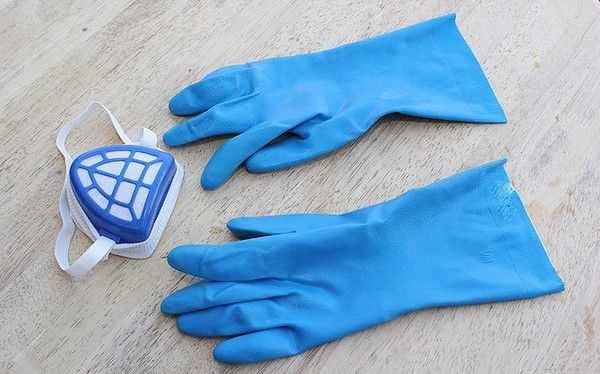

Protective equipment for handling chickens
Popular anti-flea remedies
| Name | Description |
| Beaphar drops | Natural preparation. Designed to remove fleas in dogs, but also effectively fights chicken parasites. The main active ingredient is the seed oil of the Neem tree. The drug is applied to the poultry skin. Protects animals from fleas for about 30 days, so after this time, the procedure must be performed again. |
| Drops Hurtz | Intended purpose - the fight against fleas in cats and dogs. But drops are no less effective for poultry. The drug is applied to the back of the head and rubbed well. The agent spreads very quickly through the vessels of chickens and infects fleas in 24 hours. It is quite toxic, so it is undesirable to use it for chickens. |
| Insecticide Get | Insecticides Get, Cucaracha, Tetrix are used in the treatment of chicken coops and other poultry houses. At the same time, there should be no chickens inside during processing. |
Control methods
Chickens cannot get rid of a large number of parasites on their own. To bring them out, you can use different methods of struggle: traditional and modern. All of them are aimed only at destroying parasites.
Chicken coop processing
Fleas live in litter, crawl into crevices and can reappear after simple cleaning. At home, the processing of winter premises is carried out after the transfer of the bird to the summer barn:
- clean the room from litter;
- spray the selected drugs;
- the treated shed is closed for 8-24 hours, according to the instructions for the pesticide.
The summer room must be prepared for the transfer of the bird in advance. To exclude the possibility of fleas entering a clean chicken coop, birds are subjected to treatment procedures on the day of movement.
Poultry processing
Infected chickens or other breeds of poultry must be treated for parasites. To do this, use drops against fleas for dogs and cats (Bars, Dana, etc.), applying them in the same way as on animals: at the base of the neck, between the shoulder blades, on the back of the neck, where it is difficult for the bird to get the emulsion with its beak.
For protection and treatment of fleas, you can call a veterinarian at your home. Injections of the drug Ivermectin and similar agents quickly and effectively get rid of cutaneous parasites.
Powder Deltamethrin is used to sprinkle the feathers of a bird and its skin if fleas have already infected the layers. The powder can be added to ash baths so that the chickens bathe on their own. For the treatment of domestic birds, Butox or other preparations are also used, spraying the solution onto the feather and down.
Chemicals: a review of funds
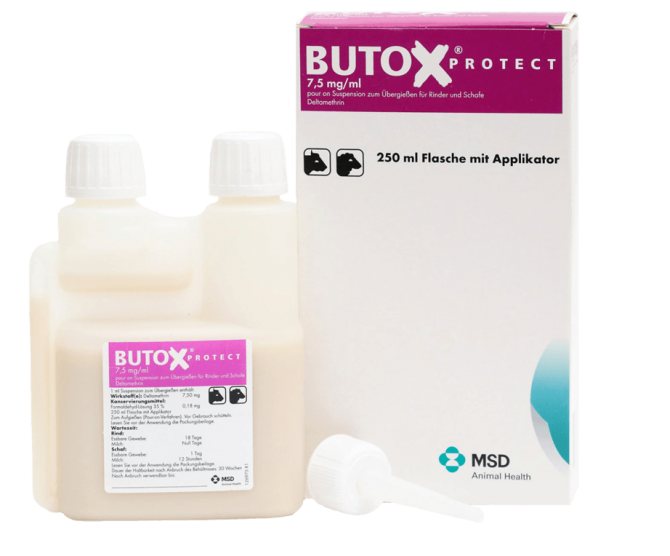

Butoks solution for the treatment of chickens.
In modern farms, it is convenient to use aerosols and solutions (emulsions) based on permethrin, karbofos and other toxic substances designed to combat crawling insects, these are:
- Butox solution (dilute the contents of the ampoule with water according to the instructions), Tetrix, Cucarachi and other drugs are sprayed with a spray bottle or garden sprayer;
- Deltamethrin is a powdery preparation suitable for dusting nest boxes, floors and other surfaces, chickens or ducks themselves using special equipment;
- Raptor, Kombat, Karbofos, Reid, etc. - ready-made sprays, used according to the instructions on the package (they spray all available surfaces), it is not recommended to handle the bird.
After spraying toxic chemicals in the hen house, the room is closed for a period of several hours to 1-2 days. During this time, most of the parasites will die in it. Ready-made sprays with permethrin, cypermethrin, deltamethrin (Reid, Raptor, etc.) are especially effective.
Small drops seep into any crevices. They act by penetrating the integuments of the body of insects, and cause their death within a few hours. They are slightly toxic for warm-blooded animals. The decomposition of the pesticide occurs within 1-4 weeks.
Folk ways
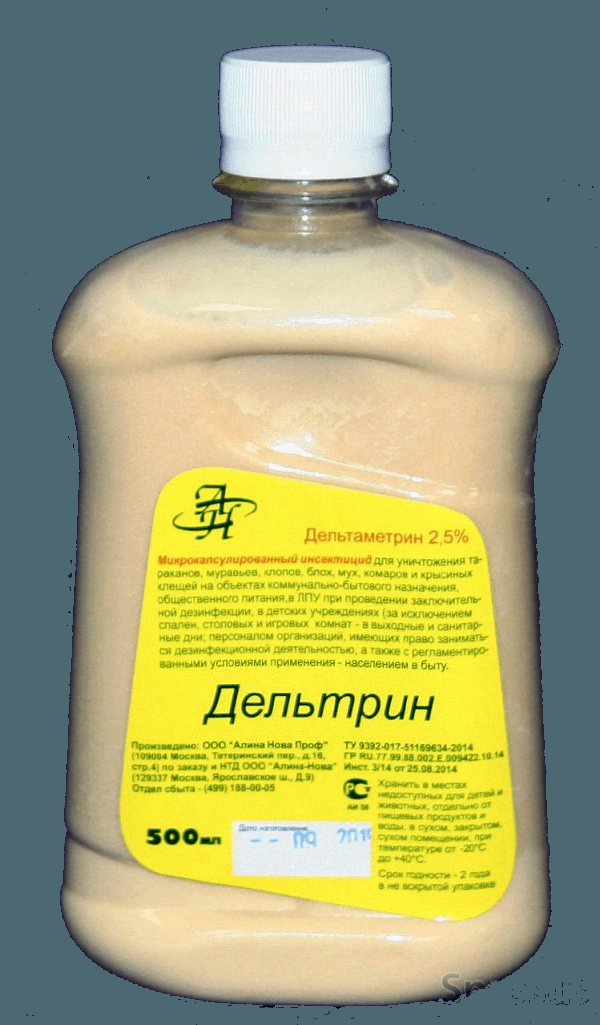

Treatment of chicken fleas with Deltamethrin.
Traditional methods of dealing with chicken fleas are based on the instinctive behavior of the bird in getting rid of any skin parasites. Birds take dust baths, falling out in sand, dry soil, etc.
At home, wood and coal ash is a good remedy. It is poured into flat containers and placed in the house so that the baths are always available.
With a strong multiplication of parasites in the ash, you can add sulfur powder (buy in a veterinary pharmacy or garden store), Deltamethrin or chopped herbs (wormwood, Persian chamomile, etc.).
Traditional methods include the separate use of medicinal plants.
The use of herbs
The ability of a number of plants to repel fleas has long been appreciated by humans and is used to treat not only dogs and cats, but also poultry. In the chicken coop, the following can be used:
- infusions and decoctions of aromatic herbs;
- dried plant powder;
- alcoholic tinctures based on poisonous flora.
Aromatic herbs are used to scare off parasites. Their essential oils are unpleasant for fleas and the parasites quickly leave the house. You can use the following varieties:
- lavender;
- tansy;
- juniper;
- geranium (houseplant);
- rosemary;
- pyrethrum;
- wormwood, etc.
To scare off fleas, it is convenient to use a powder from these herbs: the dried raw materials are ground and scattered around the chicken coop, paying special attention to the nest boxes. Chickens and their related species do not have a developed sense of smell, and it is impossible to frighten them off by smells, but larvae and adults of fleas and ticks most often live in the litter of nests.
The powder is also added to the ash baths at a rate of 1: 1. A simple bathing procedure for a chicken becomes curative if fleas have already attacked its feathers.
In addition to the dry method, strong decoctions of aromatic raw materials are used to process the chicken coop. You can brew 3-4 tbsp. l. chopped wormwood, tansy and other herbs, pouring boiling water over the plants. It is most convenient to insist in a thermos, leaving the liquid overnight. Spray the barn when cleaning using a spray bottle.
Poisonous plants are also used to kill fleas:
- wild rosemary;
- pyrethrum (persian chamomile);
- hellebore.
These varieties can be infused with vodka, combining 50-70 g of dried raw materials (or about 250 g of fresh grass) and 0.5 liters of alcohol. Insist 2 weeks in the dark, after which the medicine can be stored for 2-3 years, applied as needed. A warning label must be attached to the container, since the liquid is poisonous. Keep out of the reach of children.
Use the tincture, if necessary, as follows:
- using a spray bottle or tampon, apply the drug to the bird's skin to destroy fleas on it;
- spray all surfaces, crevices, corners in the chicken coop, and, if caged, treat both the cells and the room;
- remove and incinerate the litter from the nest, spray the box and lay on new material.
Folk remedies for removing parasites
Tansy and wormwood proved to be the best in the fight against the bird flea. These herbs have a pungent odor that will ward off parasites. It is necessary to arrange the plants in the corners of the room or its perimeter. Such activities are more relevant for prevention. In advanced cases, the use of chemicals may be required.
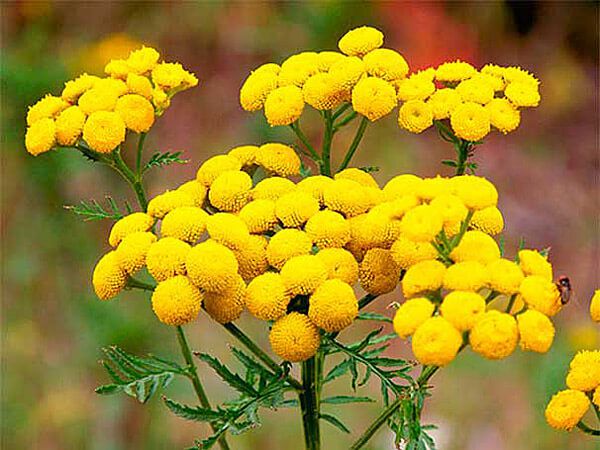

Tansy
Herbal decoction is also especially effective. It is prepared as follows:
- Tansy and (or) wormwood are poured with boiling water in a ratio of 1: 3.
- Let it brew for 12 hours.
- The chicken coop is completely treated with broth: all corners, doors, walls and perches.
Ash also helps to get rid of fleas. Outside the chicken coop, you can install a large container with ash, where the chickens will get rid of parasites on their own. This is one of the easiest prevention methods.
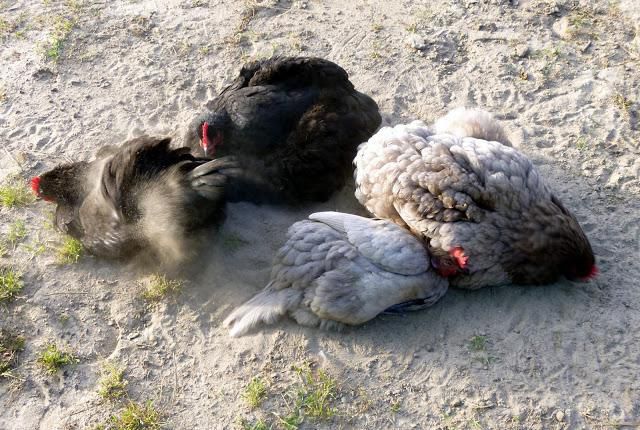

Ash baths
Signs of infection in chickens
It is necessary to start fighting fleas in chickens as quickly as possible, because the reproduction process is rapid - each female lays several eggs a day. The farmer should be aware of the signs that the birds are infested.
Some people think that chicken lice are visible to the naked eye, as in the photo, where the chicken's entire face is literally covered with brown dots. Such a picture can be seen if the case is running. Large accumulations of parasites in the area of the eyes, near the beak and on the comb indicate that the whole body of the laying hen is teeming with them.
At the initial stage, it is not easy to find lice in chickens - they are hidden under thick plumage.... Early infection can only be recognized by the behavior of the bird. The first thing that should alert the farmer is the concern of the birds. They become irritable because they are itchy. Laying hens do not find a place for themselves, trying to get rid of unpleasant sensations, some individuals rub their heads against the feeder or other equipment or peck themselves.
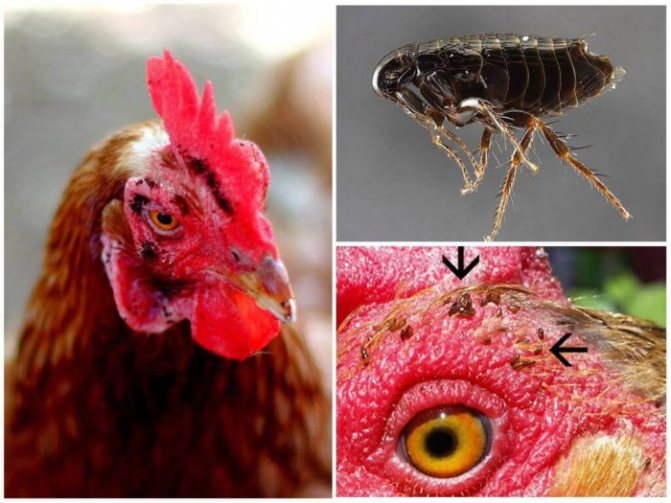

The chicken has fleas on its face
Other symptoms of fleas in chickens include:
- decrease in productivity indicators;
- weight loss;
- slow growth in chickens;
- poor appetite;
- the appearance of bald spots on the body;
- pecking.
Attention! Decreased egg production and restless behavior of the laying hen may indicate an ectoparasite infestation.
How to properly and effectively rid a bird of parasites
To rid the chickens of insects, each of them is treated with special drops - a couple of drops of the substance are applied to the back of the head and carefully rubbed into the skin. The drug enters the bloodstream and the parasites that drink it will die.
It is not recommended to use meat, feathers or eggs of chickens during the processing period, since any insecticide is harmful to the human body, can cause an allergic reaction or lead to poisoning.
The chicken coop is started at the next stage, when the bird has undergone treatment and has already been rid of parasites. It is important to understand that cleaning or washing the room before processing is a big mistake, since there are a large number of larvae in the compost and garbage. They will be able to grow into full-fledged fleas already on a heap, there they will fall on sparrows or they will independently move to the poultry house. Therefore, it is necessary to fight fleas directly in the chicken coop.
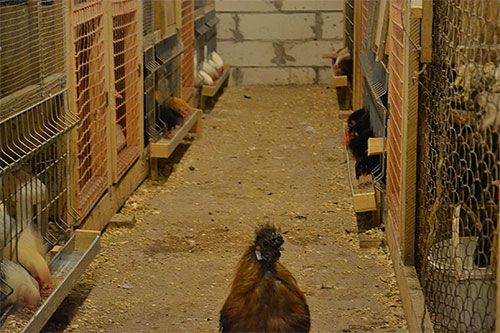

Chicken coop
It is necessary to completely clean the room from insects, also treating perches (this is where the greatest accumulation of parasites is), waste, feeders and nests. If the layer of debris is thick enough, it must be loosened and additionally treated with an anti-flea medication.
What harm do parasites do to birds?
As already noted, it is impossible to take small poultry skin parasites lightly. Such insects can cause irreparable harm to poultry. Their harmful effect lies in such moments:
- severe depletion of the infected chicken;
- constant combing by the bird itself of the affected areas of the skin, which leads to the appearance of ulcers and wounds;
- bacteria and viruses can enter the body through the affected areas of the skin;
- parasites can infect layers with dangerous diseases that can be fatal;
- egg productivity and egg quality are significantly reduced;
- there is a slowdown in growth rates and weight gain in chickens;
- a weakening of the immune system is manifested, as a result of which even frivolous colds in chickens become difficult to cure;
- anemia develops, which is caused by frequent attacks of fleas and lice.
It is also worth noting that serious infestation with lice, fleas and chewing lice negatively affects the appearance of chickens. The quality of bird feathers deteriorates, extensive bald patches develop, the skin becomes dry and wrinkled, and wounds covered with dry crusts appear in some areas. This is especially critical for chickens and roosters of decorative breeds, in which appearance is their main advantage.
How to deal with fleas with a large number of poultry?
In poultry farms or large farms where a lot of poultry is kept, these drugs are most often used:
- butox. The main active ingredient is Deltamethrin insecticide. The tool is very effective against parasites, even in the most advanced cases. Among the main advantages of Butox are the ease of preparation of a large amount of insecticidal solution. The drug is sold in 1 ml ampoules.Before use, one ampoule is diluted with four liters of water. Apply the solution to the plumage of the bird using sprayers. Butox is also applicable for the treatment of poultry houses at the same concentration as for chickens;
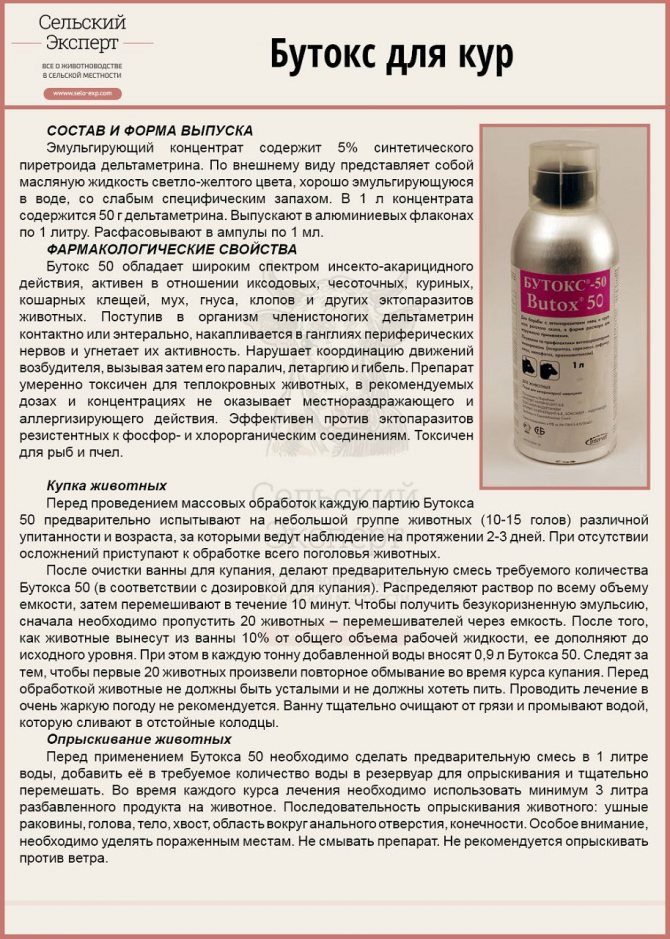

Chicken butox
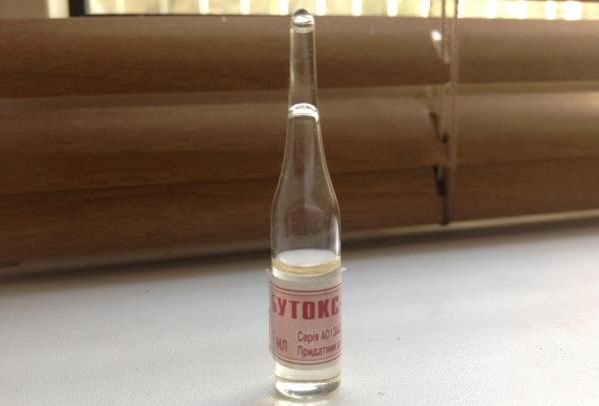

Ampoules Butox
- Deltamethrin powder is a fairly popular medicine. It consists of 50% directly of Deltamethrin, the rest is an inert powder filler. The processing of chickens is quite simple - powder is sprayed onto their plumage, and also rubbed into the skin. It can also be used on large houses if a spray bottle is available. After that, the room is not touched for several hours, but it is better to leave it for a couple of days so that all the larvae are poisoned. Next, the old litter, droppings and other debris are cleaned out, and wet cleaning is carried out. The room is ventilated, a new bedding is laid and the chickens are moved back.


Deltamethrin powder
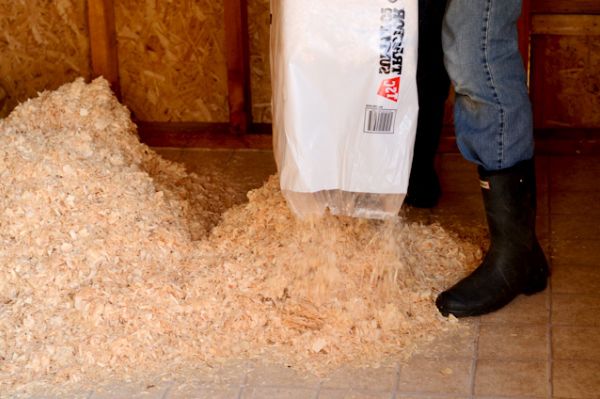

Changing the litter
Poultry litter prices
Poultry litter
Substances based on Deltamethrin should not be allowed to enter the respiratory tract and eyes of the bird. Each hen needs to be processed separately. At the same time, work with protection - rubber gloves, a mask or respirator.
Why are parasites dangerous?
Fleas feed on the blood of birds. Large colonies of jumping parasites are able to bring a well-fed hen to complete exhaustion in a matter of days. Infected individuals develop anemia and weaken immunity. The exhausted bird has no resources left to lay eggs. Productivity drops sharply, and sometimes the laying of eggs completely stops.
But this is not the worst thing - pests carry deadly infectious diseases - mycoplasmosis, salmonellosis, encephalitis, which are dangerous not only for chickens, but also for humans. Ectoparasites are intermediate hosts of some types of worms, that is, through them, chickens can become infected with helminthiases.
Fleas bite through the skin, which causes severe itching in birds. Soon, bald spots and combs form on the body of the laying hen. This can provoke cannibalism - neighbors in the poultry house begin to peck at a sick chicken. Sometimes this ends with the death of the laying hen. Worst of all, the birds that have participated in the pecking tend to attack their neighbors over and over again.
Obviously, it is necessary to fight fleas in chickens immediately after they are found. Otherwise, the farmer will face many problems - cannibalism, outbreaks of infectious diseases, helminthic invasions. All this can lead to the loss of part of the livestock.
Prophylaxis
It is important to understand that regular preventive measures will minimize the likelihood of pests affecting the bird. It is much easier and cheaper to prevent an enemy attack than to fight it.
Preventive measures are as follows:
- Keeping the house clean. Even if fleas enter the hen house through a new bird or sparrows, they will not be able to reproduce here, since the larvae and pupae will all the time be taken out with the garbage from the house. Therefore, it is important not to allow the accumulation of a large amount of garbage both indoors and in the surrounding area, regularly change the litter, adding branches of wormwood, tansy or juniper to it.
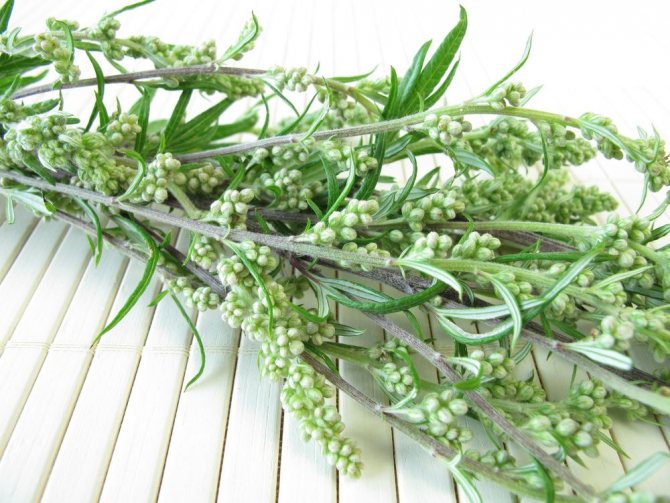

Wormwood branches
- Ash baths are an effective prophylactic agent. But it is advisable to arrange them outside the poultry house.
- Protection of the premises from the penetration of rodents. Mice and rats are among the main carriers of parasites.
- Constant examination of chickens. It is advisable to isolate the infected bird from the rest of the layers.
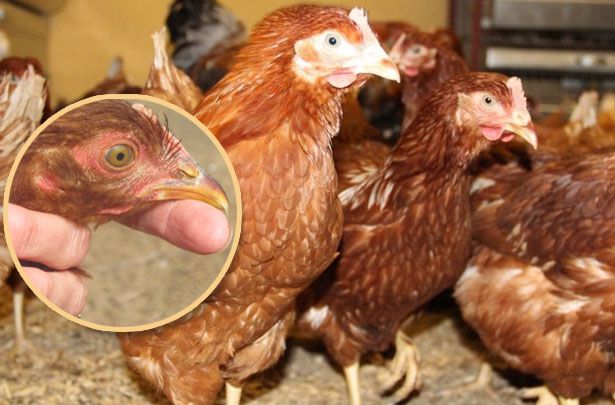

Inspection of hens
- After buying a new chicken, keep it separate for a while. It is recommended to let it go to the rest of the bird after preventive treatment.
It will not be superfluous to systematically treat broods with veterinary agents that prevent the emergence and reproduction of an insect colony.
Video - What to do if chickens have fleas?
The above activities require a certain amount of time and money. But they fully justify themselves, since much more effort and finances will have to be put in the fight against annoying insects. The pest carries a great danger, which should not be underestimated - the livestock can slowly deplete, lose strength and eventually die.
The poultry will compensate for the lack of energy by absorbing a large amount of feed, which will also affect the growth of costs. It is worth being careful, reacting to danger in time and taking preventive measures, then the chicken flea will not pose a threat to the chicken coop.
How to remove a tick from chickens
This insect is a real disaster, how to deal with them if it hides in the most secluded places of the chicken coop, where even strong solutions are inaccessible.
This is a problem not only for amateur poultry farmers, but also for industrialists. The saddest thing is that the folk method, in the form of sand baths, does not help (there is no tick on the chicken during the day, or not enough). At the moment, biologists are in search and so far no treatment has been developed.
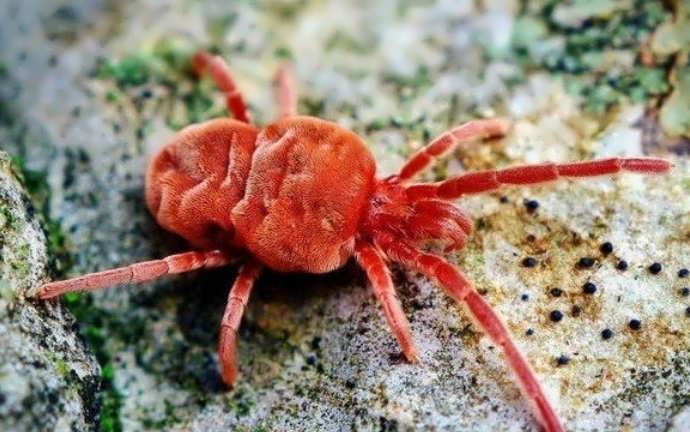

Chicken mite
Folk remedies such as garlic, vinegar, yarrow, lavender, etc. (the list goes on for a long time) do not help.
You can process the chicken coop with the drugs listed above, as well as:
- "Acromed";
- "Medifox";
- Avicin;
- Medilis.
Expert advice
Victor N. Travnikov
For about 20 years he has been breeding laying hens, broilers, geese, ducks and other poultry. Our expert who is always happy to help readers.
Ask a Question
For all drugs, the main active ingredient is permethrin. It is he who helps to cope with the tick, since other bases are powerless.
The poultry farmer may be comforted by the fact that with the onset of a cold snap, the tick hibernates (it can be hungry for 12 months). However, with the arrival of heat, it intensifies its activity. There is information that when searching for how to deal with a tick, fly sticks were used and the insect was actively sticking. But as a remedy for fleas and downy eaters, Velcro is completely unsuitable.
A very good method is lamp firing... However, it is only acceptable for metal structures.
As one of the methods, it is possible to propose to completely free the chicken coop from birds for a year. However, this does not guarantee that the imported young will be "clean".
Statistics show that there are no farms that are free of ticks. Its distribution area is so large that it becomes impossible to completely cure the livestock. Scientists-arachnologists are constantly looking for ways to combat this scourge.
Attention! If you are looking for an answer to the question of what to do if chickens have lice, fleas, ticks and are looking for information, do not follow the lead of non-professionals. It is impossible for productive animals to use drugs that are intended for fleas for dogs and cats.
If the product is not intended, then the active substance passes into the blood, meat and eggs, and a high-quality product turns into poison.
It is important not to use drugs (even as an experiment) if they are not intended for these purposes. For example, insecticidal smoke bombs ("City", "Yamal", "Quiet Evening") work well against insects, but they "do not take" red chicken mites.
Not sure what to feed your hens to make them run better? The answer is here:
Observing the habits of the bird, looking closely and listening, you can easily determine who lives on the bird. If you do this in a timely manner, then it becomes easier to cope with parasitic insects. By organizing baths, you can prevent fleas, chewing lice, and feather eaters from entering the poultry yard. Frequent cleaning, changing litter, and treating cages, nests, and perches will help regulate the mite population until it gets rid of.
Like the author! 2
- Even more interesting:
- Marek's disease of chickens: description, methods of control
- What to do if ducklings start to fall to their feet
- How broiler chickens can get sick and how to treat them
Discussion: 2 comments
- Pavlik:
12.12.2018 at 10:29Breeding chickens is nothing new to me. I have been doing this for 6 years and only recently this attack overtook me. At first, I did not know at all how to cope with this disaster. And then I began to use the advice given above and you know, they work. So far, everything is quiet and there are no parasites.
Reply
- Yana:
12/15/2018 at 20:48
For me personally, breeding chickens is not a new thing, I have been doing this for 5 years and, of course, during this period of time I have come across fleas and lice in chickens. At first, of course, you get lost, because you don't think that such a parasite can start, well, then you start a struggle and the methods described above are familiar to me. they work.
Reply
Preventive measures
In order not to have to deal with parasites dangerous for poultry, it is worth regularly taking preventive measures, which are as follows:
- timely cleaning of the chicken coop - changing the old litter to a new one, not only on the floor, but also in the nests;
- regular disposal of chicken droppings and feed residues, which are a good breeding ground for parasites;
- periodic inspection of the entire livestock for the presence of sucking parasites;
- ensuring proper conditions of detention - good ventilation, humidity at 50% and temperature in the range of 15-18 °.

